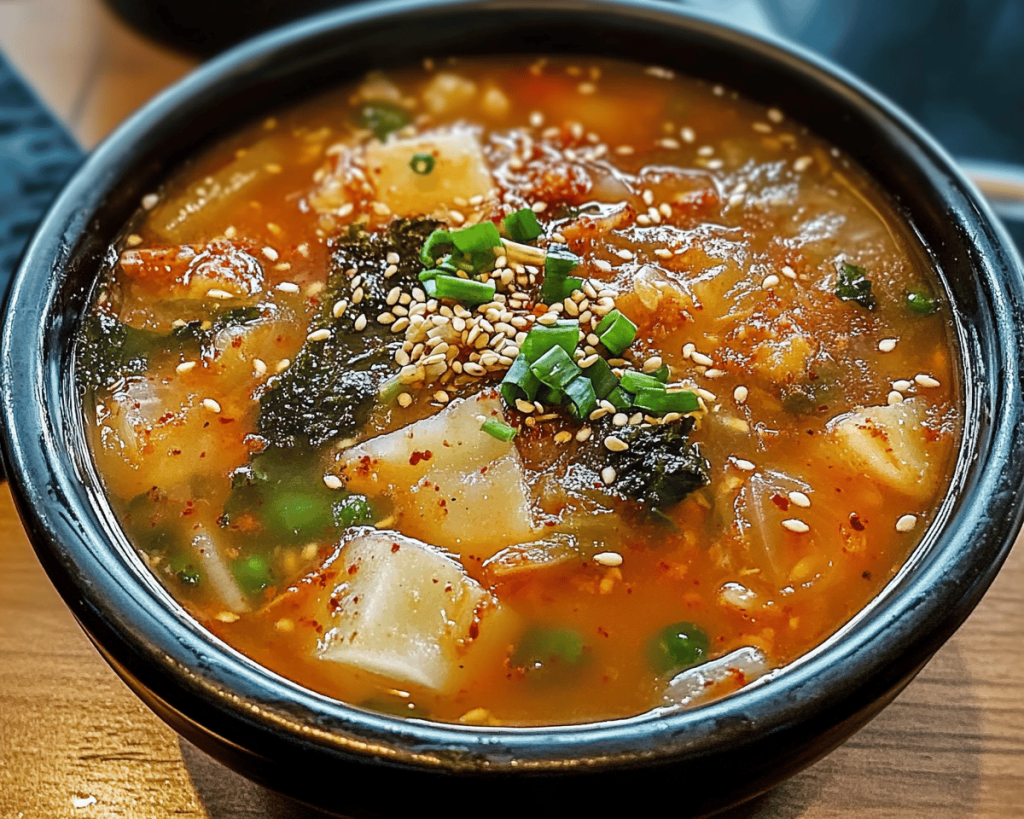There’s something comforting about a bowl of soup, especially during the frost-laden days of winter. Each sip seems to wrap you up in warmth, like a knitted scarf pulled tight around your neck. When I think of winter soups, my mind drifts to the gentle, aromatic essence of Korean cuisine—its rich flavors, the soft crunch of vegetables, and the heartiness that nourishes both body and soul. Korean winter soups always remind me of home, of cozy evenings spent huddled around the table with loved ones sharing stories and laughter.
On particularly chilly nights, with a soft blanket thrown over my lap and the sounds of distant laughter echoing from the street, I find myself gravitating towards a humble yet beautiful pot of **Kimchi Jjigae**, the beloved Korean kimchi stew. It has a beautiful rustic charm. The spicy-sour notes of aged kimchi mingling with tender tofu and savory pork create a symphony of flavors that sing of tradition. It’s funny to think how a meal can remind you of so many intimate moments—my friends and I experimenting with spice levels, my mother teaching me how to stir the bubbling broth so it wouldn’t froth over. But more importantly, it reminds me of how food connects us.
The very act of simmering the soup allows the rich landscape of flavors to unfold, transforming simple ingredients into a warm embrace. I always start the process with a quiet reflection in the kitchen. The first sniff of kimchi brings me straight back to my grandmother’s kitchen, where she would make sure that every jar of fermented kimchi was perfectly spiced, its scent filling the air like an old friend’s laughter. The memories of my family bustling around her would wrap me up in nostalgia as I pull out the ingredients for my own version of this winter comfort.
Behind Every Ingredient
– Kimchi: Ah, the heart and soul of this stew! There’s a story behind every jar of kimchi, isn’t there? I still remember the first time I made kimchi on my own. My aunt guided me through the process, teaching me the right balance of salt and spice. That evening, as we rubbed the chili paste into each cabbage leaf, we shared tales of our family history. Kimchi is not just a condiment; it’s a testament to our heritage, something that connects every Korean across the globe. Each bite tells a story of fermentation, patience, and the love infused into it.
– Pork belly: The choice of protein can sway the stew in various directions, but I love the richness that pork belly provides. The first time I popped a piece into my mouth and let it melt away, I understood the magic of its fat layers, creating a luxurious texture while balancing the sharpness of the kimchi. In my home, we often debated whether to use pork or tofu, but I find that the melding of flavors with pork belly adds that extra touch of coziness.
– Tofu: This humble bean curd is like the quiet friend in a group; it embraces all flavors without demanding the spotlight. For me, adding tofu creates a delightful contrast, especially when it absorbs the piquant broth. I love to carefully slice it, feeling its silky smoothness glide through my fingertips, each piece a gentle reminder of how simplicity can bring depth.
– Green onions: A burst of brightness, green onions are the final flourish on the dish, like the laughter that lingers long after a joke has been told. Chopping them sends tiny scents of spring into the air as I slice, and sprinkling them on top just before serving makes my heart dance with joy. They remind me of the freshness that can cut through the richness of the dish, revitalizing it.
– Garlic: The unmistakable aroma of sautéed garlic fills the kitchen like a warm hug. I close my eyes and allow the fragrance to take me back—a memory of my mom rushing to the stove, soft background music playing, filling our home with an inviting atmosphere. Garlic will always hold a special place in my heart, infusing both flavor and love into each recipe.
– Soy sauce: A splash of soy sauce deepens the broth, a reminder of life’s tangy surprises. Each drop is rich with umami, making everything feel just a little more alive, enlivening moments shared over dinner.
– Sesame oil: It’s funny how just a few drops of sesame oil can transform a dish. The nutty aroma dances through the kitchen, enveloping everything in its embrace. Growing up, I’d watch as my grandmother would drizzle this liquid gold just before serving, and I’d always get curious about the flavor it was adding to the meal. Now, it feels like a comforting ritual for me too, a thin stream that enhances the entirety of its complex taste.
– Water: Often overlooked, water holds the power to bring everything together. As I pour it into the pan, I silently thank it for its ability to carry flavors, to fill spaces, and to quench our thirst not just for nourishment but for connection.
Comfort Meets Care: Is It Healthy?
In this world of culinary indulgence, sometimes I find that we lose sight of what it means to enjoy food healthily. Kimchi Jjigae strikes the perfect balance for me. While it might lean towards indulgence with its pork belly, it also bursts with health from the fermented kimchi—a probiotic powerhouse that supports gut health, and the boatload of vitamins found in the vegetables. The challenge is in finding that balance; I extend the recipes to include more greens when I’m feeling particularly conscious.
Eating this dish feels indulgent without being guilty. It nourishes the soul and warms the spirit while respecting both the pantry and the body. We throw in ingredients like tofu that offer protein without excess calories, while the robust flavors draw you in, keeping our cravings satiated without overindulging. There’s a joy in moderation, and this stew is a heartfelt embrace that serves both comfort and care.
Ingredients for Easy Korean Winter Soup
– 1 cup of kimchi, preferably aged
– 200g of pork belly, sliced thinly
– 1 cup of tofu, cut into plush cubes
– 2 stalks of green onions, sliced
– 4 cloves of garlic, minced
– 2 tablespoons of soy sauce
– 1 teaspoon of sesame oil
– 4 cups of water
– 1 tablespoon of Korean chili flakes (gochugaru, optional, for an extra kick)
– Optional: any additional vegetables (mushrooms, zucchini, or spinach)
Here’s How I Make It
1. I begin with a sequence that feels almost ritualistic, catching glimpses of past summers in the fresh ingredients piled before me. In my big, favorite pot, the one that’s seen countless meals, I place it on the stove, letting it feel the heat underneath.
2. I heat up a splash of sesame oil. As that nutty aroma rises, I drop in my thinly sliced pork belly. The soft sizzle that fills the kitchen is music to my ears, and I stand there, stirring occasionally until the meat takes on a beautiful golden-brown hue. Each piece clinks against the pot, the rhythm of cooking that soothes the soul.
3. Then, I add a generous handful of minced garlic; the aroma envelops me like a warm hug. I could close my eyes and just inhale. Stirring it in, I make sure each piece gets coated before it begins to brown and tingle my senses.
4. It’s time for kimchi! I throw it into the pot, the bright red colors contrasting beautifully against the golden pork and white garlic. The fermentation bubbles seem to whisper stories of my upbringing as I mix it all together, letting the kimchi soak up the porkiness while releasing its spicy tang. As I stir, I consider how every ingredient is shedding its past, uniting into something new.
5. I measure out my water, pouring it over the mixture, and add the soy sauce, letting that umami sensation swirl about. Bringing it all to a boil, I become lost in the bubbling rhythm; it’s a gentle crescendo that erupts into joyous chatter.
6. Once it’s at a rolling boil, I reduce the heat, letting it gently simmer for about 20 minutes. In this time, I often step away and reflect—sometimes watching rain dance against the window panes. The smell lingers in the air, nostalgia meeting comfort in powerful waves.
7. After 20 minutes, I carefully lay the tofu cubes into the bubbling broth. A wondrous silence fills the kitchen as they sink beneath the surface, soaking up the flavors of the broth. I can almost sense them becoming eager sponges, enriching themselves with warmth.
8. In those final moments, I sprinkle in green onions and adjust the seasoning. A few shakes of the Korean chili flakes for an extra kick, perhaps—nothing too crazy, just enough to complement its depth.
9. The last step is the pinch of love. Lifting the pot from the stove fills me with a sense of accomplishment that should never be underestimated. I ladle the soup into bowls, the vibrant color topping each portion—a gift wrapped in warmth.
10. Finally, I take a moment to appreciate how it all comes together. There’s joy in serving, and I usually garnish with that last, delicate touch of green onions and a few drops of sesame oil.
My Little Secrets
When it comes to cooking, secrets often come from whispers and shared experiences. A friend once told me to keep a jar of cooked kimchi in the back of the fridge, ready to use on busy nights. It’s a trick I’ve cherished during my own weeknight cooking. You can also play with the protein—sometimes I swap out pork for beef or even a vegetarian option, and it always feels like a new adventure.
And if I’m feeling extra fancy, I’ll serve it over a bowl of steamed rice, creating a sort of harmony between the hearts of Seoul and my own little home. Sometimes, I break out the good chopsticks and share the love with friends over a raucous night of games, reminding me that food isn’t just about sustenance, but connection.
The grandest secret I’ve learned, though, is this: as each spoonful carries warmth into my belly, I realize that this simple recipe has grown with me, evolving through shared experiences, laughter, and a profound sense of belonging.
Every pot of kimchi jjigae tells a story, and it is that very narrative that stitches us together, uniting flavor, memory, and heart.
As I sit down to savor the first bite, my eyes flutter close, a familiar taste infusing comfort into the moment. There are stirrings of laughter echoing through my heart; it’s incredible how food has this way of bringing joys back into our lives. A simple winter soup on a chilly evening reminds me of family, friends, and the warmth shared around the dinner table.
In this swirling dance of flavors and aromas, I find not only nourishment but also the quiet power of connection—the way food can link us to our heritage, to those we love, and to the profound joy that often resides in the simplest moments. In this bowl of soup, I find comfort, care, and above all, a piece of home once again.



